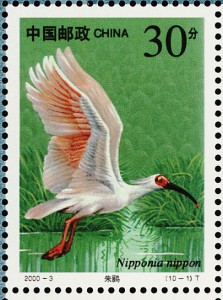Week 56 – 06 August 2017:
Evaluate, Then Reevaluate
All birds are beautiful. Some are more peculiar-looking than others, but that makes them all the more special. The Crested Ibis is just such a bird. With a red face, a mullet of long white feathers, and a ridiculously-long decurved bill, they make you want to take them home and feed them fresh muffins.
At one time, the Crested Ibis had a comparatively large breeding distribution in Russia, China and Japan. As a result of hunting, and destruction and pollution of their wetland habitat, the population fell and fell. In 1981, only seven wild individuals were known in central China.
But the news is not all bad. Although still considered to be endangered by the IUCN, the global population has now risen to something like 250 mature individuals. The best of their habitat in China’s Shaanxi Province is secure. In Japan, the village of Niibu-mura is home to the Sado Japanese Crested Ibis Conservation Centre, with captive-breeding facilities that may soon allow for releases into the wild. There is even talk about the possibility of establishing a wild population of ibis in South Korea. Of late, reproductive success has been quite high in both wild and captive populations. With that good news comes the opportunity to reevaluate management practices.
Flooded paddy fields and the wetlands that surround them are important habitat for Crested Ibis. They hunt there for fish, frogs, mollusks and aquatic insects. Winter is particularly challenging for these birds because their food is often in short supply. When research was conducted fifteen years ago, the single most important factor determining winter habitat use by Crested Ibis was the the size of paddy fields. Large fields from which one crop a year was harvested, followed by a long period of flooding, seemed to suit the birds best.
Since that study, the number of Crested Ibis, and the area occupied by the population, has expanded greatly. Can-Shi Hu of Beijing Forestry University and colleagues reexamined winter habitat use by Crested Ibis at the Hanzhong Crested Ibis National Nature Reserve in central China. Their methods were straightforward. They conducted field surveys in December 2011 and January 2012, and noted the habitat characteristics of used and unused paddy fields, reservoirs, mud flats and riverbanks. Binoculars, a motorbike and notebooks constituted their field gear.
Fifty-four sites were utilized by ibis, and fifty were not. Flooded paddy fields were still utilized, but mudflats and riverbanks had also become important sites for foraging. The size of paddy fields had proven important in the earlier study, but now the most important habitat features were the degree of human disturbance, the softness of the foraging substrate, and the distance to the nearest road. This sort of information can guide management practices in the decades to come.
Hu et al. wrote that for the sake of the Crested Ibis: “the local people should be encouraged and compensated to maintain single crop cultivation, plow paddy fields after harvesting, and irrigate them with shallow water in winter.” However, in recent years, many young people in Xangxian County have abandoned their farming income to become migrant workers. This migration has resulted in less of the habitat that is most desirable to Crested Ibis. Agricultural practices in the area are also shifting away from the type that results in ideal winter foraging habitat.
Even so, I remain optimistic. A little encouragement and compensation can go a long way.
Hu, C.-A., X. Song, C.-Q. Ding, Y.-X., Ye, B.-P. Quing and C. Wang. 2016. The size of winter-flooded paddy fields no longer limits the foraging habitat use of the endangered Crested Ibis (Nipponia nippon) in winter. Zoological Science 33:345-351.
Photo credits: Crested Ibis stamp from China – www.pinterest.com; Crested Ibis – www.chinauniquetour.com



